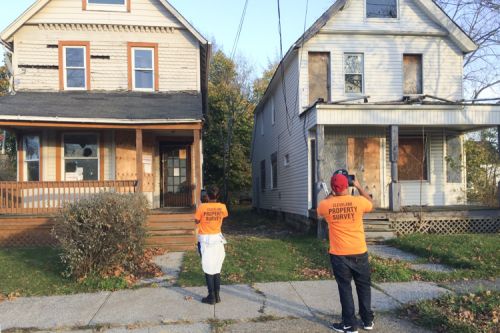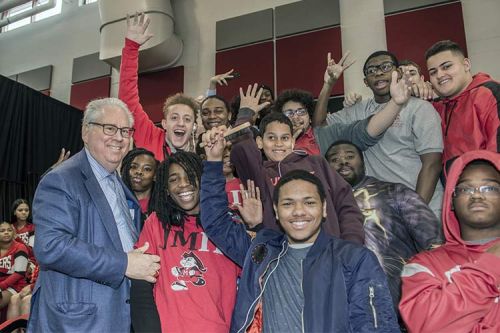Glenville
5 up-and-coming artists to watch in Cleveland
From a dynamic duo bringing back Glenville to a Sudanese designer working on a welcome center for Irishtown Bend, these artists are changing the city's creative landscape.
Summer Sprout takes urban gardeners from rookies to green thumbs
Replacing urban vacant lots with green spaces provides countless benefits for local neighborhoods, but one of the most rewarding parts of the city's gardening program is seeing beginning gardeners transform into leaders.
Shiny and not-so-new: Celebration of Preservation honors CLE's shining stars in historic restoration
Cleveland has had its shares of ups and downs in the 223 years since Moses Cleaveland first set up shop, but many of the city’s homes and buildings have remained—largely due to those who have put forth tremendous efforts to preserve and restore the structures that form Cleveland’s unique history.
Is 10 years the magic number when it comes to a more sustainable future for CLE?
When the Cuyahoga River caught fire on June 22, 1969, a 23-year-old Frank G. Jackson had just returned home from his tour of duty in the Vietnam War, and he remembers the eco-catastrophe as being “probably the last thing on [his] mind” at that time. A lot has changed in 50 years, and the now-Mayor of Cleveland is squarely focused on not only the health of the Cuyahoga River, but the city’s sustainability as a whole.
Land Conservancy study finds Cleveland's east side neighborhoods rebounding from foreclosure crisis
Cleveland's east side is steadily emerging from the 2010 housing crisis—with the number of vacant and distressed structures decreasing significantly while home prices are on the rise.
So go the findings of a 2018 report by the Western Reserve Land Conservancy that examined 13 Cleveland neighborhoods (including Fairfax, Slavic Village, and Shaker Square).
So go the findings of a 2018 report by the Western Reserve Land Conservancy that examined 13 Cleveland neighborhoods (including Fairfax, Slavic Village, and Shaker Square).
The 8 most interesting houses in Cleveland, second edition
In a city with architecture as unique as the people who call it home, we decided it was time to take another look at some of Cleveland’s most unique houses. From a pre-Civil war homestead to an ultra-modern villa, all eight of these local homes have a captivating story to tell.
Three years and 800 rides later, Squad FiftyOne is Cleveland's go-to transport for pet emergencies
Yalanda Medina is a rescue woman—a rescuer of pets in need. In 2016, she started her pet emergency medical response company Squad FiftyOne on Cleveland’s east side—one of only a few such companies in the country.
A new chapter: Cleveland Public Library prepares for the next 150 years
The "People's University" will enter its next era with an ambitious, library-wide revitalization project and a yearlong CPL150 celebration, along with the announcement that it will now be fine-free.
The state of Cleveland print media: Local journalists ponder journalism in the next era
Anyone who set foot in the Beachland Ballroom last Saturday might have thought the rumors of print media's demise have been greatly exaggerated. At the sold-out Concert for Truth, more than 450 people gathered to show their support for local journalism and those who bring us the news every day. The event featured 11 local musicians who volunteered their time and talents to raise about $5,000 for the 24 Plain Dealer employees who are being laid off after March.
Why Say Yes to Education is a game-changer for not just CMSD students, but all of Cleveland
With 20 cities in the running, Cleveland’s chances of becoming the next Say Yes to Education chapter—and only the fourth in the country to receive the distinction—were just a paltry five percent. Yet according to Say Yes founder George Weiss, it was no contest.
Fresh Lab brings the funk to Detroit Shoreway
Refresh Collective has long been hanging out at the intersection of cool, creativity, and community, but now it has an actual brick-and-mortar storefront to call all its own.
Miracle on Sowinski Avenue: St. Casimir Church becomes the first local church to go green
One may not normally think of a 127-year-old church as a leader in green infrastructure practices, but St. Casimir Church—based in Cleveland's St. Clair-Superior neighborhood—has set an example as the first Cleveland Catholic Diocese church to begin installing a green infrastructure on its campus.
New Glenville creative arts learning center aims to inspire youth
FRONT International may have concluded its colorful run, but the former FRONT Porch space in Glenville will continue its arts and culture legacy with the opening of the new Center for Arts-Inspired Learning—a creative arts center for children and teens set to open this Sunday, October 21.
Cleveland's baby boomers will soon have better healthcare in the neighborhoods that need it most
Almost 20 percent of Clevelanders are over age 60, with another 15 percent between 50 and 60 years old. Cleveland’s population is aging, and with that comes the need for comprehensive healthcare. Chicago-based Oak Street Health is answering that call with plans to open three healthcare centers this fall in medically underserved Cleveland neighborhoods.
Greener pastures: A new generation of farmers is taking the reins in Cleveland
A new generation of farmers is taking shape, both in Cleveland and around the country. According to the latest Census of Agriculture, the number of farmers under 35 years old is increasing for only the second time in the last century. Meet four young Clevelanders who are venturing outside the city limits to pursue new agricultural adventures: Carl Harp Nursery, Bellwether Farm, and Frayed Knot Farm.
Literature changing lives: Books@Work helps local veterans start a new chapter
At 10 a.m. on a Thursday, a group of veterans has gathered in the TV room at the VA Domiciliary in Glenville. These veterans grew up in different cities in varying socio-economic settings. They served in different wars and suffer from different challenges: addiction, depression, homelessness, loneliness, PTSD. Today, they have one thing in common: “The Smiling People” by Ray Bradbury.
A Clevelander's field guide to hugging a tree this Arbor Day
Anyone who’s heard of the Cleveland Tree Plan knows the city has big things in store when it comes to greening our urban spaces—namely increasing the tree canopy from 19 percent to 30 percent by 2040. Mayor Jackson announced the goal last year on Arbor Day, and efforts continue as we approach Arbor Day 2018. Looking for ways to help Cleveland get from Point A to Point Tree? Here are four ways to help reforest The Forest City.
Free Stamp: All things free in the #CLE for April 2018
Fresh Water's monthly "Free Stamp" feature rounds up the freshest free events in Cleveland.
Neighborhoods by the numbers: How the new Progress Index is a win for CLE residents
Three years in the making, Cleveland Neighborhood Progress (CNP) is ready to release its Progress Index to the public. Aimed at fostering inclusive Cleveland communities of choice and opportunity, the Index had previously been available to Cleveland’s 31 community development corporations (CDCs), who helped test and fine-tune the tool.
Free Stamp: All things free in the #CLE for January 2018
The best things in life are free, indeed, and our monthly "Free Stamp" feature rounds up all of the free #CLE events that get our "stamp" of approval. See what's on tap for January here.



















